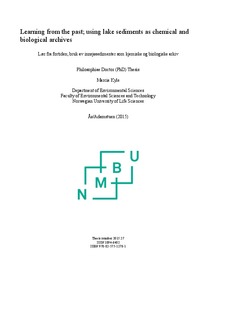| dc.contributor.advisor | Rohrlack, Thomas | |
| dc.contributor.advisor | Haande, Sigrid | |
| dc.contributor.advisor | Riise, Gunnhild | |
| dc.contributor.author | Kyle, Marcia | |
| dc.date.accessioned | 2017-07-12T08:48:46Z | |
| dc.date.available | 2017-07-12T08:48:46Z | |
| dc.date.issued | 2017-07-12 | |
| dc.identifier.isbn | 978-82-575-1278-1 | |
| dc.identifier.issn | 1894-6402 | |
| dc.identifier.uri | http://hdl.handle.net/11250/2448504 | |
| dc.description.abstract | This thesis advances the analysis of the organic fraction of sediment to reconstruct
lake history using DNA fragments and algal pigments in combination with available
monitoring data. These methods were tested in southern Norwegian lakes where
sediments had less than ideal conditions for preserving algal residues.
Because of it’s importance for water quality, the cyanobacterium genus
Planktothrix was emphasized in these sediment analyses. Recent research on this group of
organisms has demonstrated that there are genetic groups (chemotypes) with distinct
differences in oligopeptide composition, and that these differences can be attributed to
ecological functions. Four chemotypes have so far been detected in Norway. These four
chemotypes could be specified by PCR amplification of sediment DNA so that a
reconstruction of historical changes in Planktothrix communities could be developed.
This information was also be used to study the relationships between Planktothrix
chemotypes and their specific parasites (chytrids), and examine how they affect
proliferation and diversity of Planktothrix chemotypes in southern Norwegian lakes.
The most important innovation in this thesis was the development of PCR-based
methods that enabled use of lake sediments to study ecological questions in a way not
previously possible. The results indicate that DNA methods can be important tools for
gaining ecological information from lakes with no historical monitoring data, and in
particular to increase ecological understanding of the key genus Planktothrix. As a result,
this method has the potential to increase our understanding of aspects of Planktothrix that
are important for water management. | nb_NO |
| dc.description.abstract | Denne avhandlingen videreutvikler metoder for analyse av den organiske
fraksjonen av innsjøsedimenter, slik at vi kan rekonstruere innsjøens historie ved hjelp av
DNA-fragmenter og algepigmenter i kombinasjon med tilgjengelige overvåkingsdata.
Disse metodene ble testet i sør-norske innsjøer hvor sedimentene hadde varierende evne
til å bevare algerester.
På grunn av dens betydning for vannkvaliteten, ble cyanobakterieslekten
Planktothrix vektlagt i disse analysene. Nyere forskning på denne organismegruppen har
vist at den består av genetiske grupper (kjemotyper) med tydelige forskjeller i
oligopeptid-sammensetning, og at disse forskjellene kan konsekvenser for økologiske
funksjoner. Fire kjemotyper har hittil blitt registrert i Norge. Disse fire kjemotypene kan
påvises ved PCR-amplifisering av sediment-DNA, slik at en kan rekonstruere historiske
endringer i Planktothrix-samfunnet. Denne informasjonen kan også brukes til å studere
forholdet mellom Planktothrix-kjemotyper og deres spesifikke parasitter (chytrider), og
undersøke hvordan disse påvirker spredning og mangfold av Planktothrix-kjemotyper i
sør-norske innsjøer.
Den viktigste innovasjonen i denne avhandlingen var utviklingen av PCR-baserte
metoder som muliggjorde nye anvendelsert av innsjøsedimenter for å studere økologiske
spørsmål. Resultatene tyder på at DNA-metoder kan være viktige verktøy for å få
økologisk informasjon fra innsjøer med manglende eller mangelfulle historiske
overvåkingsdata, og særlig for å øke den økologiske forståelsen av nøkkelslekten
Planktothrix. Som konsekvens av dette kan metoden øke også vår forståelse av aspekter
ved Planktothrix som er viktige for vannforvaltningen. | nb_NO |
| dc.language.iso | eng | nb_NO |
| dc.publisher | Norwegian University of Life Sciences, Ås | |
| dc.relation.ispartofseries | PhD Thesis;2015:27 | |
| dc.title | Learning from the past : using lake sediments as chemical and biological archives | nb_NO |
| dc.title.alternative | Lær fra fortiden : bruk av innsjøsedimenter som kjemiske og biologiske arkiv | nb_NO |
| dc.type | Doctoral thesis | nb_NO |
| dc.source.pagenumber | 169 | nb_NO |
